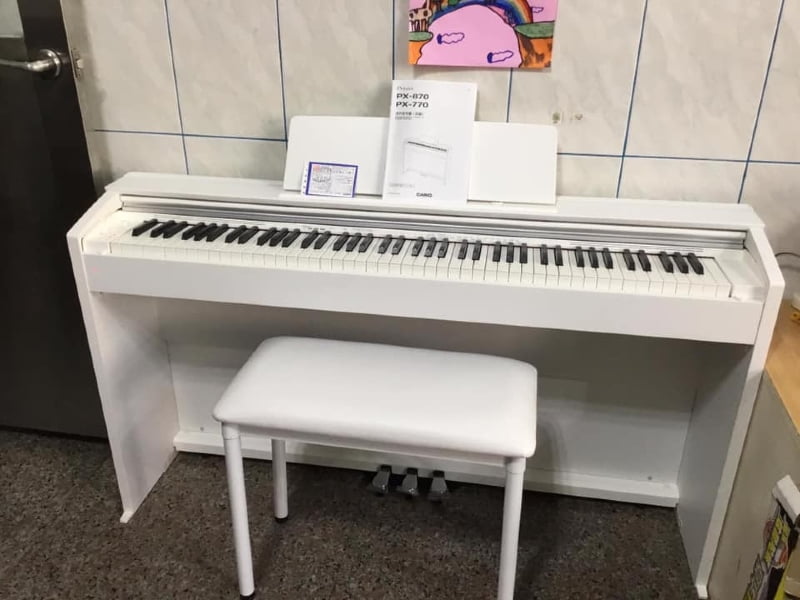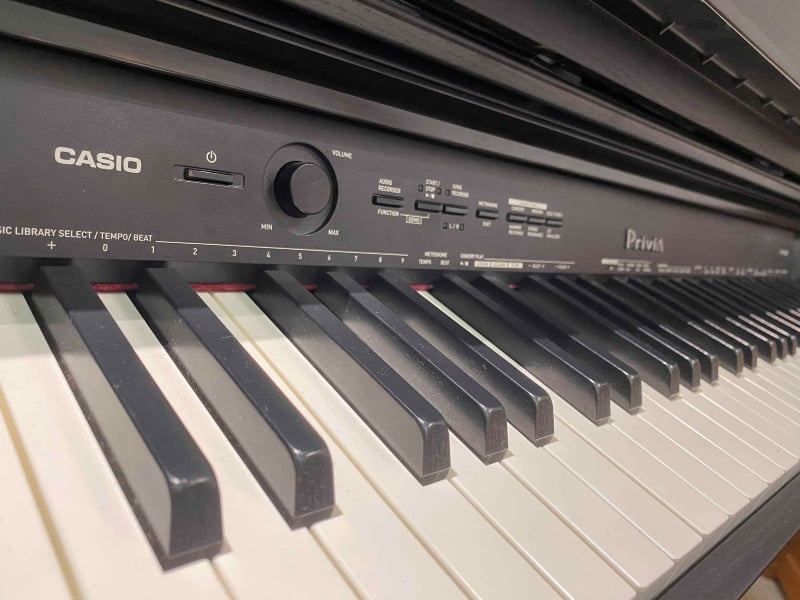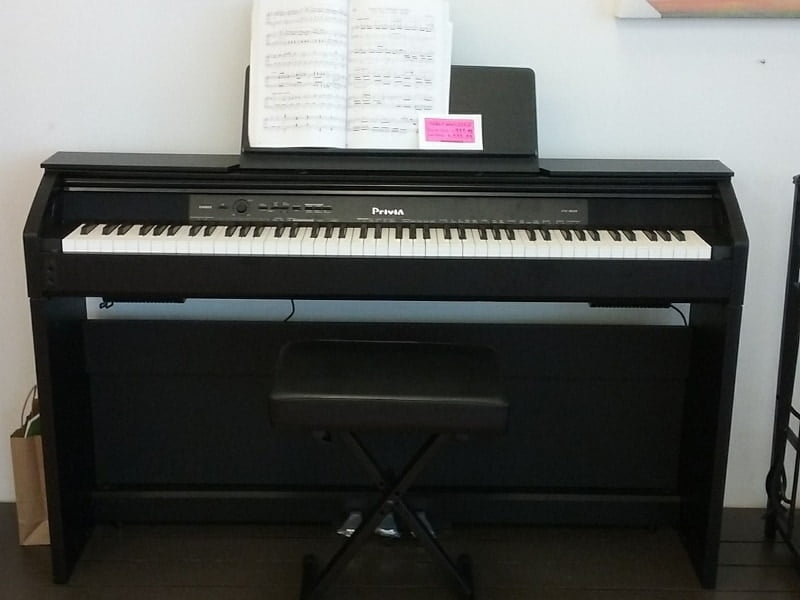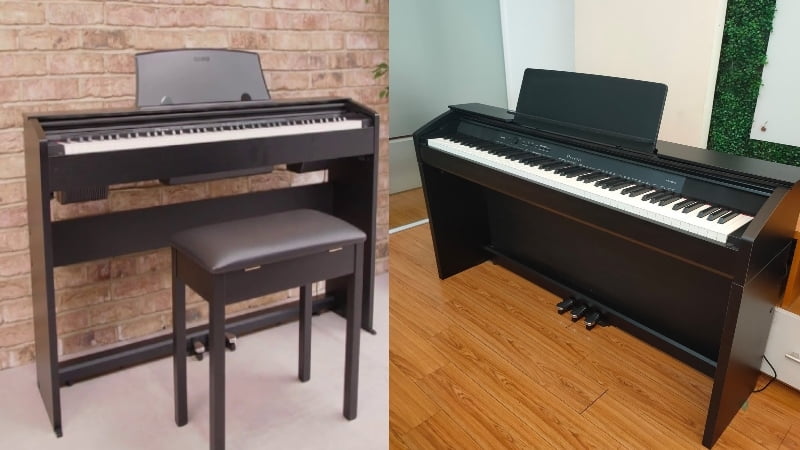Learn the differences between these two pianos and which one is the better option in this Casio PX-770 vs PX-860 review.
Casio’s Privia series is one of the most popular options for pianists on the search for a piano that doesn’t bust the bank but offers a lot of value. And two models that I want to highlight today are the Casio PX-770 and the PX-860.
I wanted to learn the differences between the two pianos and determine which one would be the better option. While I was very impressed with all the features that the Casio PX-770 offered for the price, it couldn’t compete with the functionality of the Casio PX-860, which I think is one of the best picks in the Privia collection.
In this Casio PX-770 vs PX-860 review, we’re diving into all the features and differences between these pianos. I’ll go into all the reasons why I thin the Casio PX-860 is the better option and why I still think the Casio PX-770 is a good choice despite losing the comparison.
And by the end, you’ll know all about both pianos, making it easier to choose the right option for your needs.
Casio PX-770 vs PX-860: Comparison Chart




Last update on 2025-04-17 / Affiliate links / Images from Amazon Product Advertising API
Casio PX-770 vs PX-860: A Head to Head Comparison
To find the better option between the two, I had three comparison points: tone, feel, and piano features. These are what I believe are the most important characteristics of any piano and what you should consider when buying a digital piano.
In this comparison, the Casio PX-860 came out on top with a score of 3-1. The Casio PX-770 put up a great fight in almost all categories and even grabbed a point for itself. But since the Casio PX-860 is the more versatile and premium option, it won the entire comparison.
Tone
The winner: Tie
The one comparison point where I couldn’t choose a winner was the tone. While I expected the Casio PX-860 to come out on top, I was surprised to find that these pianos have the same tone generator. And even if the Casio PX-770 has one more voice than the PX-860, it wasn’t enough to win the point.
+Tone Generator
Both of these pianos utilize the AiR Sound Source. This is a great tone engine that you’ll find on many Casio pianos in this price range. And despite the name, the generator still relied on samples and didn’t have complex software to generate and synthesize the sounds.
This tone generator is significantly better than the ones you’ll find on cheaper pianos, largely because of the sample quality. Casio has specifically designed the speakers to play the samples and send out sound in the way an acoustic piano will.
This is why the Casio PX-770 and the PX-860 come with some of the clearest and brightest piano tones in the price range. When testing the pianos out myself, I could barely tell the difference between the two. So, if you’re particular about tone quality, both pianos offer realistic and bright voices.

+Sound Library
The second aspect of a piano’s tone is the sound library. And with most digital pianos, you shouldn’t expect the widest range of options. That’s why I was pleasantly surprised that both the PX-770 and PX-860 come with a fair amount of voices to play around with.
The PX-860 comes with 18 distinct sounds. This includes a couple of acoustic and electric piano tones, bass, strings, organ, and synth sounds. The PX-770 sports a similar library with one additional tone, which adds a bit of versatility.
But to be honest, the one tone barely makes a difference. All you get is an extra grand piano tone which is great, though you can easily get by with the top-quality piano tones on the Casio PX-860 as well.
Feel
The winner: Casio PX-860
It’s very important to find a digital piano that feels close to an acoustic piano. This adds another layer of realism to your playing, and it will help you forget that you’re playing a digital instrument. And between these two pianos, I found that the Casio PX-860 has a much better feel. With a more sophisticated hammer action system, there was no way that the Casio PX-770 could compete.
+Hammer Action
You’ll be glad to know that both pianos have scaled hammer action. This means that the lower keys will be slightly heavier than the higher keys. This is the same way most acoustic pianos are setup so it offers a bit more realism than your typical fully-weighted key system. The Casio PX-770 uses the Scaled Hammer Action system, while the PX-860 has the upgraded Scaled Hammer Action II system.
The main difference between the two is the spring back time. The PX-860 springs back a bit faster despite the weight, which is similar to the way premium acoustic pianos are built. So, if you’re looking for a more realistic weight to your piano, I highly suggest getting the PX-860.
Piano Features
The winner: Casio PX-860

The comparison point that cemented the PX-860 as the winner was the piano features. The Casio PX-860 has a higher maximum polyphony and better effects than the PX-770, This gives you a wide range of versatility which is very important for pianists that play a wide range of genres and styles.
+Polyphony
The Casio PX-860 has 256-note maximum polyphony, which is much greater than the 196-note polyphony of the Casio PX-770. To be honest, this won’t make much of a difference if you’re a beginner and playing basic piano pieces. But as you progress, you’ll start seeing the value of a higher maximum polyphony.
Polyphony is a piano’s ability to play notes at the same time. So, higher polyphony means you can play more notes. While you won’t play 256 notes at the same time with any piano piece, this comes in handy when blending two voices together or when trying to express yourself with the sustain pedal.
Again, this is a very small issue for beginners. But for novice and advanced pianists, the polyphony allows you to be more expressive in your playing.
+Effects
Another reason I preferred the Casio PX-860 is the effects. Since this piano is designed for more advanced pianists, it comes with a range of controls you can apply to the tone. And while the PX-770 doesn’t have a bad effects set, I found the effects on the PX-860 to be much more useful.
While the PX-770 has reverb and chorus effects, the Casio PX-860’s hall simulator and own chorus effect are much better. On top of that, you have brilliance control as well as DSP for come tones on the PX-860.
Again, this won’t matter that much for beginners. But if you’re really looking to take full control over your tone, the PX-860’s effects can help you do that.

Casio PX-770 vs PX-860: The Similarities
While these pianos have a lot of differences, they still share some similarities. To start, they both feature textured keys. This is so that the keys feel much more natural compared to other digital pianos. However, the downside is that they aren’t real wooden keys, so they still have a plastic feel to them.
These pianos are in a similar price range, with the PX-860 being slightly more expensive. However, you can go for either of these pianos and expect to save some money, especially compared to other digital pianos with a similar feature set. And while they don’t have the widest tone libraries, they are more than decent for any beginner or novice pianist.
Another major similarity is that none of these pianos are portable. These are console digital pianos, so they are designed to stay in one place. While this does get in the way of flexibility and versatility, it allows you to have richer and deeper tones.
Quick Rundown of the Casio PX-770
- 88 scaled, weighted hammer-action keys with simulated ebony and ivory textures
- Stunning new piano sound with detailed resonance, plus 18 other Tones
- Stereo speaker system built into stylish, modern wooden cabinet
- Versatile practice, performance, and MIDI recording tools
- 3 year manufacturer extended warranty
Last update on 2025-04-17 / Affiliate links / Images from Amazon Product Advertising API
Quick Rundown of the Casio PX-860
- Keys: 88 Ebony and Ivory feel
- Keyboard - Action: Tri-sensor Scaled Hammer Action Keyboard II
- Keyboard - Touch Response: 3 sensitivity levels, off
- Keyboard - Key Off Simulator: Yes
- Sound - Source: Multi Dimensional Morphing AiR
Last update on 2025-04-17 / Affiliate links / Images from Amazon Product Advertising API
Product Video
Related Articles to Casio Px 770
- Casio PX-770 vs Korg B2SP: A Battle of Budget Console Digital Pianos?
- Casio PX-770 vs Kawai KDP-110: The Best Console Digital Pianos on a Budget?
- Casio PX-770 vs Kawai ES-110: Should You Get A Portable or Console Digital Piano?
- Casio PX-770 vs PX-160: Should You Get A Portable or Console Digital Piano?
- Casio PX-770 vs S1000: Should You Get A Portable or Console Digital Piano?
- Casio PX-770 vs 750: Finding the Best Budget Digital Piano
- Casio PX-770 Vs AP-270: Which Casio Model Wins Out?
- Casio PX-770 Vs 760: Which Is The Better Casio Privia Model?
- Casio PX-770 Vs Yamaha DGX-660: Should You Get A Portable Or Console Digital Piano?
- Casio PX-770 Vs Yamaha YDP-143: Which Is The Better Piano For The Money?
- Casio PX-770 Vs Roland FP-30: Should You Get A Portable or Console Digital Piano?
- Casio PX-770 vs Yamaha YDP-144: Which Is The Better Digital Piano?
- Casio PX-770 Vs 780: What’s The Difference Between These Two Digital Pianos?
- Casio PX-770 Vs 870: Which Casio Console Digital Piano Is Better?
- Yamaha P45 vs Casio PX 770: Should You Get the Portable or Console Digital Piano?
- Yamaha P125 vs Casio PX-770 Review: Why the Yamaha P125 Beats Out the Casio Console Digital Piano
Related Articles to Casio Px 860
References:
- Casio PX-770: https://www.sweetwater.com/store/detail/PX770BK–casio-privia-px-770-black-finish
- Casio PX-860: https://www.casio-intl.com/asia/en/emi/products/px860/spec/
Lulacruza is an electronic folk duo operating at the junction of the hypermodern and the ancient. Our music weaves together hypnotic female singing, South American folk instruments and electronic processing, while channeling pulsating waves from the source of creation.
Lalucruza is also a community where you can connect with other music lovers to collaborate, exchange ideas and share knowledge. A platform for who wants to learns the basics of playing piano, guitar, drum masters’ technique, etc.. is the premise of our website.
